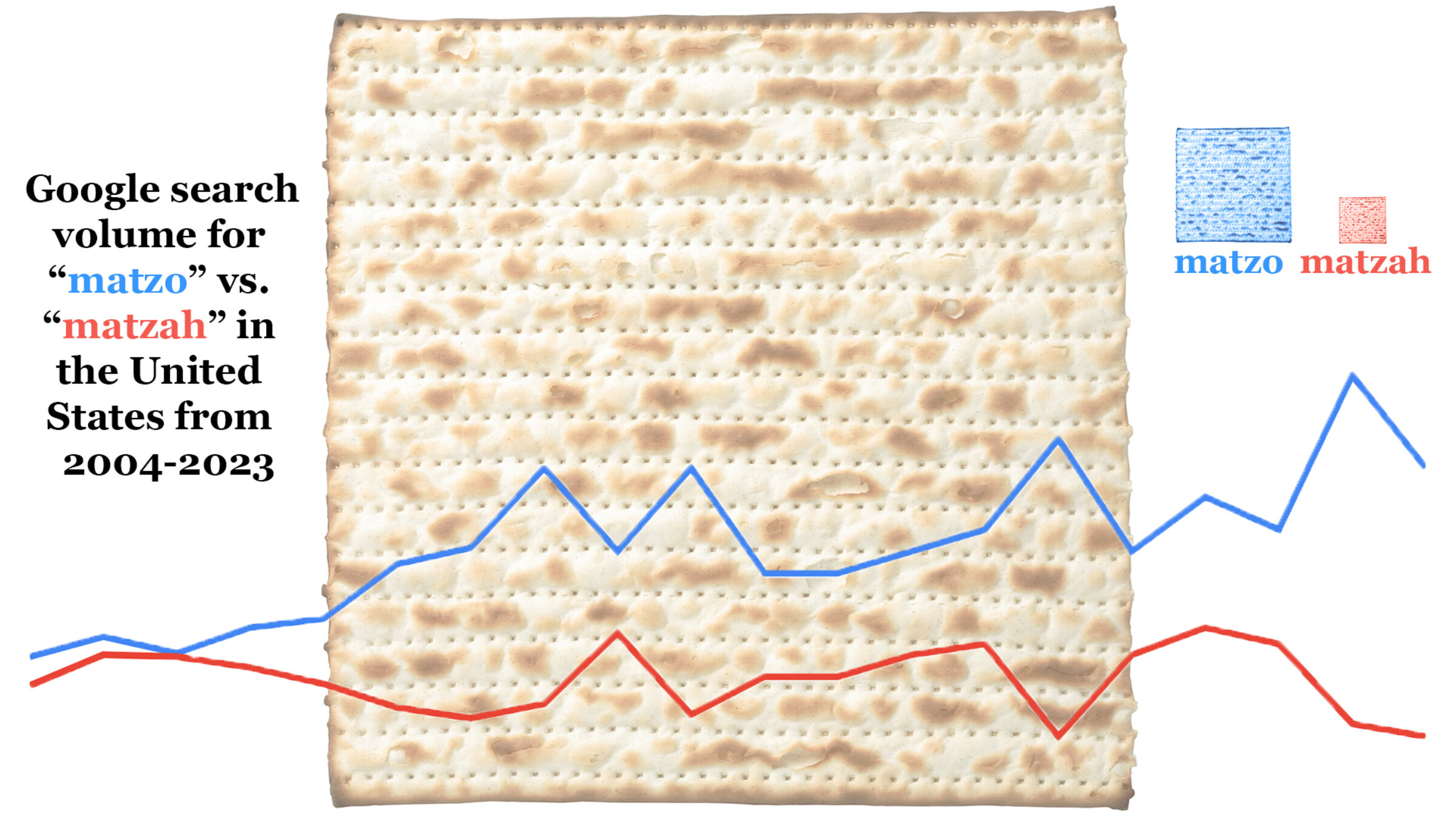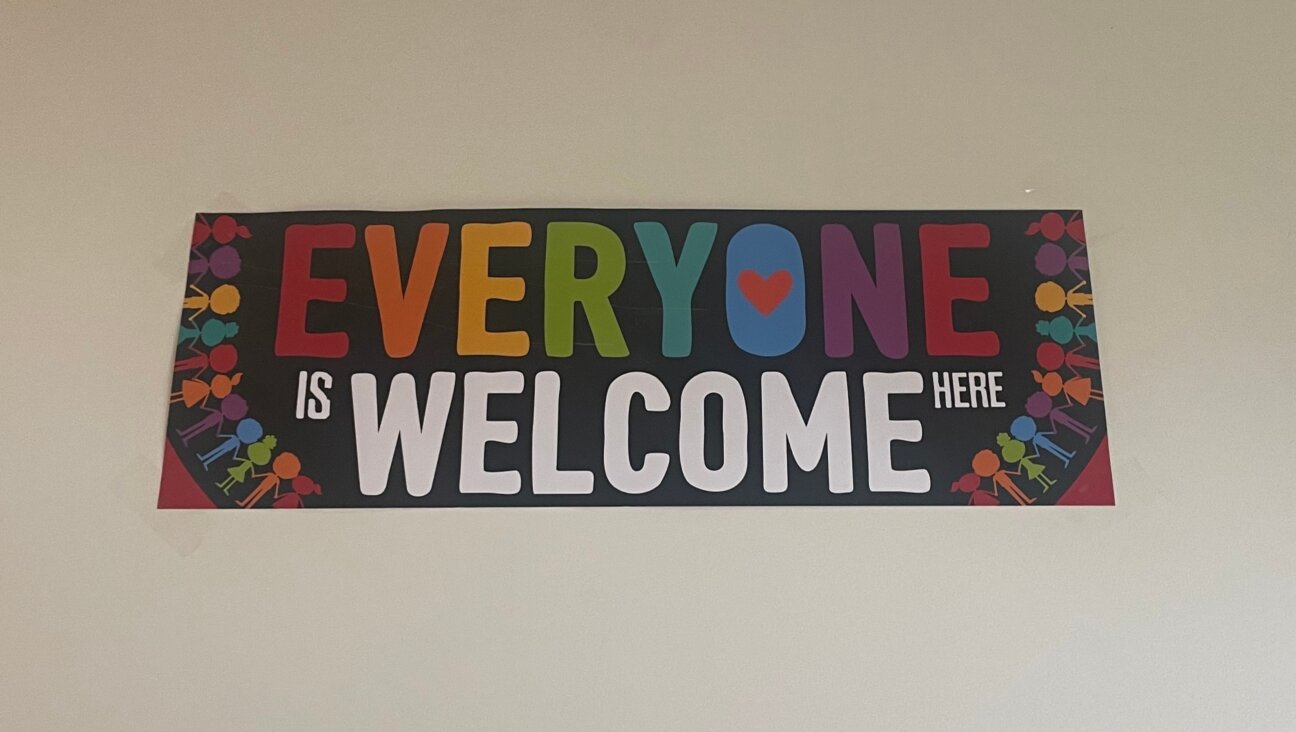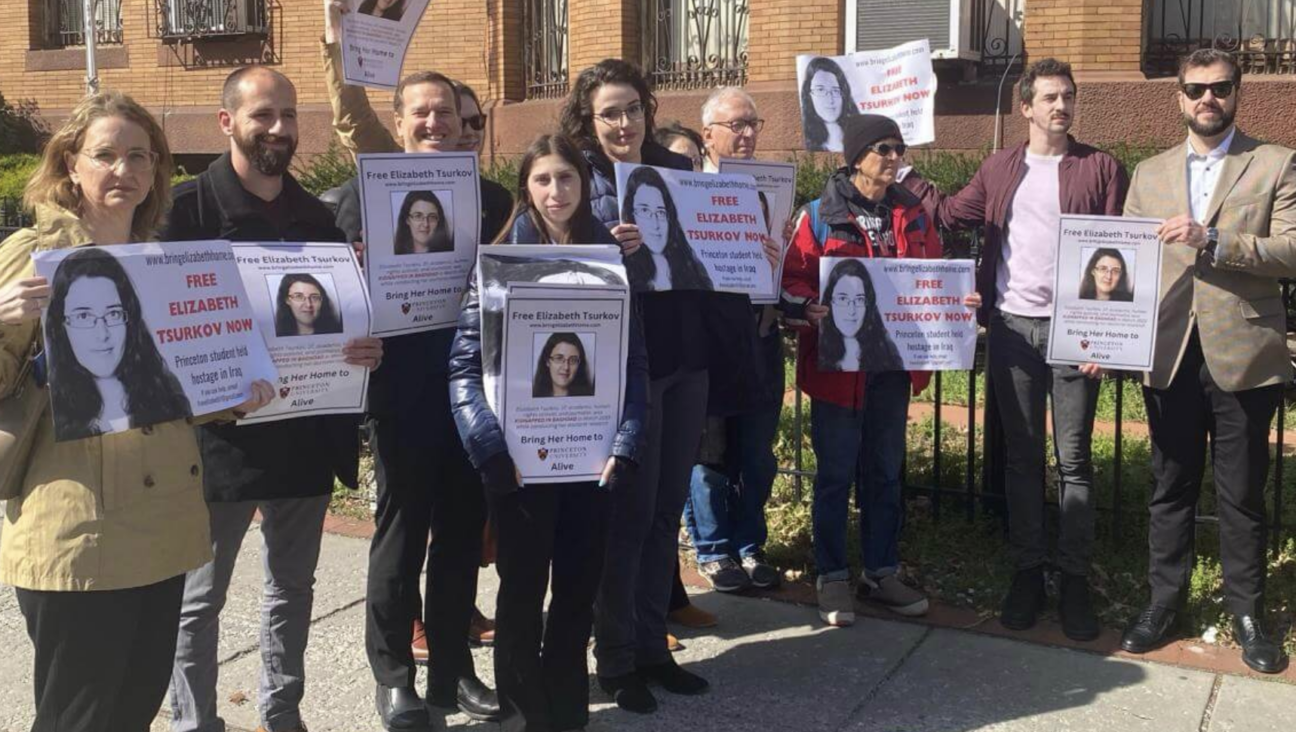This is our editor-in-chief’s weekly newsletter. Click here to get it delivered to your inbox on Friday afternoons. When our senior copy editor, Beth Harpaz, sent an email a month ago reminding our staff how to spell common Purim and Passover terms, one of our reporters sent up a flare.
“Am I the only one who thinks ‘matzo’ is odd in 2023?” asked Louis Keene, a millennial based in forward-thinking LA. “Why the reversion to Ye Olde Haggado Style?” Sigh. No, Louis, you are not the only one. ‘Matzo’ is almost objectively odd, an English spelling that does not reflect the way I’ve ever heard anybody pronounce the Hebrew word for unleavened bread. And yet: As Beth and I muddled through scores of transliteration dilemmas to update the Forward stylebook last year, we discovered that ‘matzo’ has a surprising amount of sticking power, and not just to your gut. The Associated Press Stylebook, which the Forward follows unless there’s a compelling reason not to, uses ‘matzo,’ as does Merriam-Webster. Ditto The New York Times and Louis’ hometown paper, the Los Angeles Times. But our partners at the Jewish Telegraphic Agency and Haaretz prefer matzah, which is part of why our own digital archives are inconsistent. Wikipedia switched to -ah last year, after several rounds of deliberations over two decades. Since we’re talking about food, we also checked popular recipe sites, which similarly lack consensus: Allrecipes uses matzah, Bon Appetit matzo, Food Network both. Plus: Google search volume has been larger for matzo than for matzah every year since 2004, and the gap is growing, not shrinking, as shown in the graph below. “The search data don’t lie: ‘matzo’ is more searched than ‘matzah’ by a landslide,” noted our opinion editor and resident data nerd, Laura E. Adkins. That means keeping ‘matzo’ will make Forward Passover stories and recipes easier for people to find. “I personally prefer matzah,” said Benyamin Cohen, news director and host of our morning briefing, Forwarding the News. “Perhaps more importantly, Google prefers matzo.” |
This may seem like small potatoes (potato starch?) given that Israel is on the brink of disaster, our former president is on the brink of indictment, abortion access is in peril, antisemitic propaganda is skyrocketing, the pandemic persists, and, you know, climate change. Fair. But as I wrote in 2020, when we started capitalizing Black, swapped anti-Semitism for antisemitism and generally favored Haredi over ultra-Orthodox, spelling counts — or, as Abraham Joshua Heschel said, “Words create worlds.” Some argue that matzo with an o is based on the historic Ashkenazi dominance of Jewish discourse in the U.S., and thus exclusionary of Sephardic Jews and others from different backgrounds, so this is not just a quibble over spelling. The two core principles that guide our stylebook are readability and consistency. We want the broadest possible audience to engage with our journalism without stumbling over unfamiliar words or having to stop to look stuff up. And we want the spelling and other style points to be the same whether you’re reading a news, culture or opinion piece from yesterday or yesteryear. We think of ourselves as a 125-year-old startup, which means evolving with our communities while honoring our past. “Louis is always the wicked child in these things,” Beth joked. “Every time I send out a thing about style, Louis is always the one who says, ‘That’s wrong!’” “No, I don’t say ‘That’s wrong!’ I say, ‘Why?’” Louis corrected. Which is always the right question in my book. So we got into it. We did the research about other publications and public searches. We looked at the history and the etymology across three languages. We crunched the data. And we talked it out. “As a person who thinks about language a lot, and who cares about language a lot, my personal philosophy is that language is alive and language changes,” Beth explained. “I don’t stand in the way of common usage being different from archaic usage or some high-falutin’ version of how we talk. Ultimately, we want our words to be easily recognizable to readers.” Score one for Louis. His argument is that matzah is clearly how we talk. His concern is that people seeing matzo will pronounce it wrong — like the non-Jewish woman he once dated who called it matt– (as in mattress) zoh (like zohar). So what’s going on with Google? It seems we can blame Rabbi Dov Behr Manischewitz, the Lithuanian immigrant to Cincinnati who in 1888 became the first commercial seller of unleavened bread for Passover in the United States. (Yes, Manischewitz beat Streit’s by 28 years, and no, the company’s first product was not kiddush wine. Who knew?) Rabbi Manischewitz spelled it matzo. Perhaps now is the time to note that the second syllable of the Hebrew word for this food item uses a vowel known as kamatz — you remember from Sunday school? The one that looks like half a plus sign? — whose pronunciation is somewhere between the English “ah” and “oh” (think: rhymes with “son.”). Manischewitz, like legions of Eastern European Jewish immigrants of his time, was a Yiddish speaker, which some see as explaining his spelling choice. But our Yiddish editor, Rukhl Schaechter, said definitively: “No one pronounces it this way any more.” Today’s Yiddish speakers, Rukhl said, say the second syllable “rather like a short ‘e,’ as in bed.” Which is why the YIVO standard of Yiddish transliteration is matse. I wondered if the company Manischewitz founded, which sells 800,000 pounds of matzo a year, had ever had an employee like Louis propose changing the spelling on its boxes. So I called up Shani Seidman, chief marketing officer for Kayco, the kosher goods giant that bought the brand in 2019. The short answer was “no,” but the longer one was pretty interesting. “I think at Manischewitz, while we do enjoy innovation and creating new products,” she said, mentioning red velvet macaroons and their new resealable pouch as examples, “we always feel like there’s a heritage and a value to that heritage that anchors us, and feel very secure in keeping part of our heritage alive. I’m not saying that the ‘o’ is the anchor of our heritage and we’re relying on that, but it represents the confidence and the pride we have in the heritage of the brand. “There’s a joke in my family: We always say, ‘Pass the matz-oh,’ we know that it’s spelled a different way than we say it,” Seidman said. “The discussion we have around here is more, ‘What new products can we bring? What new recipes can we enhance? How can we improve the recipes that we have in terms of health?’ We’re going to leave the ‘o’ in matzo.” |
“As a person who thinks about language a lot, and who cares about language a lot, my personal philosophy is that language is alive and language changes. Ultimately, we want our words to be easily recognizable to readers.” |
– Beth Harpaz, senior copy editor, the Forward |
As I was doing all this research, I noticed that those Manischewitz boxes — and the ones from Streit’s, Yehuda and the newest brand on the market, Trader Joe’s — not only had an ‘o’ but an ‘s.’ As in, matzos. Which exactly nobody ever says in casual conversation (we do refer to Passover as “chag hamatzot” in various prayers, matzot being the Hebrew plural of matzah, but I digress). Because, in English, matzo is both singular and plural. Like fish, which you might just have as a first course at your Seder. You would not say, “I need three matzos for the Seder plate,” you’d say, “three pieces of matzo.” Right? I ran it by Beth, who worked at the AP for three decades and is my style and grammar compass. “Put the matzo on the table … she went out and bought some matzo … I’m just trying to make a sentence in my head,” she said, leaning her head back and closing her eyes. “Do we have enough matzo for the Seder? … You’re right, it doesn’t have an ‘s.’” At least that much is clear. Matzo-vs-matzah, not so much. I started out the week thinking this column was going to be an explanation of our rationale for using ‘matzo’ in the Forward. As I talked to more people around our newsroom and read up on the debates that have happened elsewhere, I considered changing our official style — matzah seems more readable, more inclusive and more modern, all things we want to be, need to be. But as Laura put it, search data don’t lie, and we’ve already published a trove of fresh Passover stories with the ‘o’ this season, including Mira Fox’s fascinating exploration of why some Christians use matzo for communion, and her very fun recommendations of Trader Joe’s-inspired matzo snacks. So I’m punting for now. Maybe next year not only in Jerusalem, but with matzah. |
Thanks to Laura E. Adkins, Matthew Litman and Samuel Breslow for contributing. Shabbat Shalom! Questions/feedback: [email protected] |
YOUR TURN: MATZO v. MATZAH LET US KNOW WHAT YOU THINK |
I’ve laid out the history. I’ve shown you the data. I’ve shared our philosophy — and our internal questions. Now we want to know what you think. Click the blue button below to tell us if you think the Forward should keep using the spelling matzo or change it to matzah, and why. |
YOUR WEEKEND READS A FREE, PRINTABLE MAGAZINE OF STORIES TO SAVOR OVER SHABBAT AND SUNDAY |
|
|
| Our cover story this week is about the 1939 pageant at Madison Square Garden in which Hollywood stars pleaded with the public to stop the genocide of Europe’s Jews. Inside, some lighter fare, including the history of the Passover marshmallow, as well as Rob Eshman on why Americans like Jews; Benjamin Ivry on why no one talks about I.L. Peretz anymore; and Jacob Kornbluh’s interview with a Reform rabbi who is a leftist member of Israel’s Knesset and says to American Jews: “This is not a time to be silent.” Download the printable (PDF) ➤ |
|
|
Shani Seidman, the Manischewitz marketing guru I spoke to about matzo, said the company now has a “Baskin-Robbins” of flavors — red velvet, as mentioned above, but also cappuccino chip, carrot cake, birthday cake, pistachio orange. I have, personally, never eaten a store-bought macaroon worth the calories or effort. They’re just not yummy. But a few years ago, my friend Esther Bloch brought homemade chocolate ’roons to a Seder at my sister’s in Chicago, and I’ve since been making them year-round. I literally have the simple recipe — printed from a photo Esther texted me — tacked up on the bulletin board in my kitchen. Beat 3 egg whites until very stiff; fold in 7 oz. flaked coconut, 1/2 cup sugar, 1 tsp. vanilla and 6 oz. melted chocolate chips; drop by teaspoonful on cookie sheets; bake at 325 F for 17 minutes. Rukhl, our Yiddish editor and cooking maven, promises me that the Southern-Style Pecan Macaroons she and Eve Jochnowitz make in this episode of our Yiddish cooking show are equally delicious and easy to make. Don’t worry, there are subtitles! |
JOIN THE CONVERSATION UPCOMING EVENTS |
April 2 @ 3 p.m. ET | Museum of Jewish Heritage (NY) and online
Adam Langer, host of our hit podcast diving into the cultural history of The Diary of Anne Frank, will talk with members of the original Broadway and touring companies about the impact the show had on their lives. These actors have not been in the same room for seven decades. Register now to join us in person on or via livestream ➤ |
|
|
YOUR FIRST TRIP TO ISRAEL |
With Israel turning 75, we’re collecting photos and memories about people’s first trips to the holy land. Below are some from our journalists — that’s Matthew Litman, with the tank in 2004. And our publisher and CEO, Rachel Fishman Feddersen, on the Otzma program in 1992. Send your images and stories to [email protected], subject line: My first trip to Israel. |
|
|
|






































